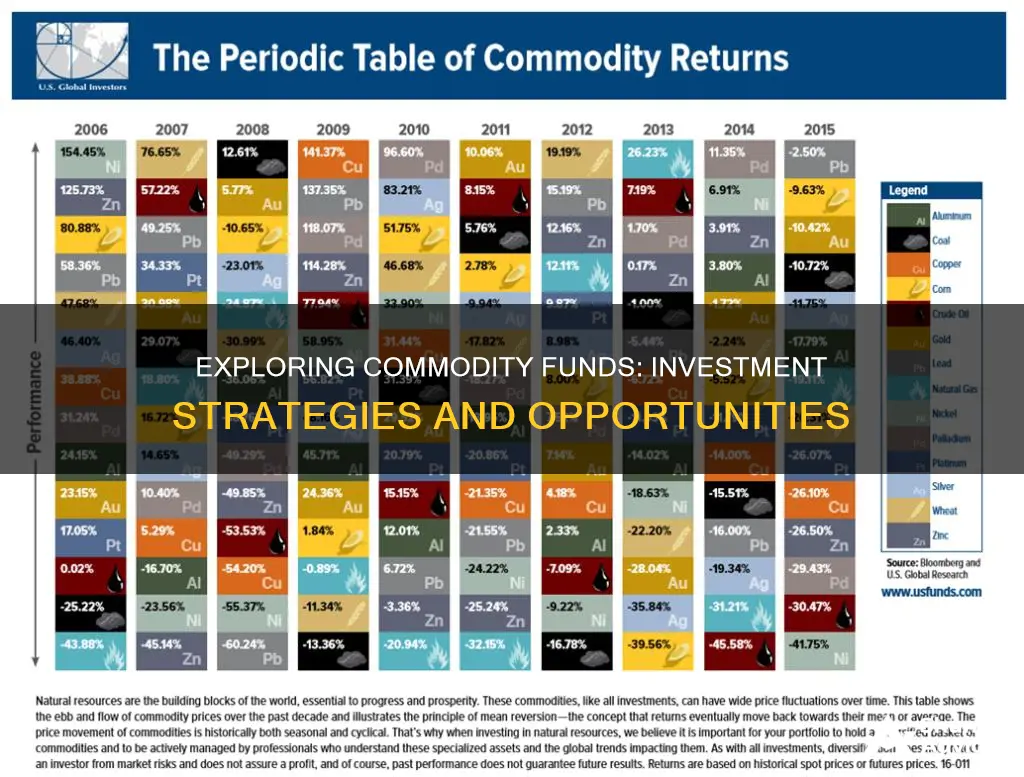
Commodity funds are a type of investment fund that focuses on commodities, which are raw materials or primary agricultural products. These funds invest in a range of commodities such as precious metals (e.g. gold and silver), energy resources (e.g. oil and natural gas), and agricultural goods (e.g. wheat). They can also invest in companies that produce these commodities, such as those in the energy, mining, oil drilling, and agricultural industries. Commodity funds offer investors a way to diversify their portfolios and protect against inflation, as commodity prices tend to rise with inflation. However, investing in commodities can be risky due to the volatile nature of commodity markets, which are influenced by various factors such as supply and demand, political and economic conditions, and exploration risk.
| Characteristics | Values |
|---|---|
| What they invest in | Raw materials or primary agricultural products, known as commodities |
| Examples of commodities | Precious metals (e.g. gold, silver), energy resources (e.g. oil, natural gas), agricultural goods (e.g. wheat) |
| Other investments | Companies that produce these commodities |
| Benefits | Portfolio diversification, protection against inflation, potential financial growth |
| Types | Index funds, "true" commodity funds, futures-based commodity funds, natural resource funds, combination funds |
| Risks | Commodities markets can be volatile, commodities are exposed to political, economic, foreign currency and exploration risk |

Precious metals
Gold is the most popular precious metal for investment purposes. It is considered a strong hedge against inflation, is durable, and is a good conductor of heat and electricity. It is also in high demand for jewellery, its primary use, and is commonly used as a form of currency.
Silver is the second most popular precious metal for investment. Its price is influenced by its dual nature as a store of value and an industrial metal. Silver is used in electrical appliances, medical products, and other industrial items.
Platinum is rarer than gold and is often traded at a higher price. It is considered an industrial metal and is mostly used in automotive catalysts, jewellery, petroleum and chemical refining, and the computer industry.
Palladium is a lesser-known precious metal with many industrial uses. It is used in manufacturing processes, dentistry, medicine, chemical applications, jewellery, and groundwater treatment.
There are several ways to invest in precious metals:
- Buying physical bullion, such as minted coins or bars, and storing them in a safe deposit box.
- Buying futures contracts for a particular metal.
- Purchasing shares in publicly traded companies engaged in the exploration or production of precious metals.
- Investing in mutual funds and exchange-traded funds (ETFs) that offer exposure to precious metals.
Some examples of precious metals funds include:
- Allspring Precious Metals Fund (EKWAX)
- Fidelity Select Gold Portfolio Fund (FSAGX)
- Gabelli Gold Fund (GLDAX)
- Victory Capital Precious Metals and Minerals Fund (USAGX)
- Invesco Gold and Special Minerals Fund (OPGSX)
Unlocking Your Money: Withdrawing from Mainstay Investment Fund
You may want to see also

Energy resources
Examples of renewable energy resources include solar energy, which is derived from the Sun's electromagnetic radiation and can be used directly for heat or converted into electricity for other uses. It is a nearly unlimited, renewable, and non-polluting source of energy. Another example is wind energy, which involves harnessing the wind to drive turbines and generate electricity.
On the other hand, non-renewable energy resources include fossil fuels such as coal, oil, and natural gas. These are formed from the buried remains of ancient plants and animals and are non-renewable on a human time scale. Nuclear energy, produced from uranium through nuclear fission reactions, is another example of a non-renewable energy resource.
Commodity funds, which invest in raw materials or primary agricultural products, also invest in energy resources such as oil and natural gas. These funds may also invest in companies operating in the energy sector, such as those involved in oil drilling and mining.
Index Funds: Choosing the Right Investment Strategy
You may want to see also

Agricultural goods
Commodity funds are a great way to invest in raw materials or primary agricultural products. These funds invest in agricultural goods such as grains, dairy, and livestock. They can either invest in a bundle of commodity types or focus on one specific commodity.
Commodity funds are a great way to gain exposure to the agriculture sector. With the world's population expected to exceed 9 billion by 2050, the demand for food and agricultural products is projected to soar and remain high for the foreseeable future. This makes agricultural goods a very attractive investment opportunity.
- Grains: Wheat, corn, and soy are some of the most commonly traded grains in the world. They are used for human consumption, animal feed, and even fuel production.
- Dairy: Milk, cheese, butter, and other dairy products are in high demand worldwide and are often included in commodity funds.
- Livestock: Cattle, pigs, and sheep are commonly traded as livestock commodities. They are used for meat production, leather, and other by-products.
- Fertilizers: With the increasing demand for food, fertilizers are becoming more important to ensure crop growth and protection. Fertilizer ingredients such as potash and phosphates are often included in commodity funds.
- Agricultural equipment: Companies that manufacture and sell agricultural equipment, such as tractors, ploughs, and irrigation systems, are also included in some commodity funds.
Commodity funds that invest in agricultural goods can be a great way to diversify your investment portfolio and take advantage of the growing demand for food and agricultural products. However, it is important to note that commodity prices can be extremely volatile and are subject to various factors such as supply and demand, exchange rates, inflation, and economic conditions.
Unlocking Abakkus Growth Fund: A Guide to Smart Investing
You may want to see also

Natural resources
Natural resource economics deals with the supply, demand, and allocation of the Earth's natural resources. The field aims to understand the role of natural resources in the economy and develop more sustainable methods of managing those resources to ensure their availability for future generations.
Natural resource funds are a type of commodity fund that invests in companies engaged in businesses that operate in commodity-related fields, such as energy, mining, oil drilling, and agricultural businesses. While these funds typically do not hold actual commodities or commodity futures, they provide exposure to the commodities market by proxy.
Commodity funds that invest in natural resources offer several benefits to investors, including portfolio diversification, protection against inflation, and potential financial growth. The prices of commodities tend to rise with inflation, making them a hedge against inflation. Additionally, commodities have historically had a low correlation with stock market movements, providing diversification to an investment portfolio.
The demand for commodities is subject to the laws of supply and demand. When demand rises, prices generally follow, resulting in profits for investors. However, commodity markets can be volatile, with prices fluctuating due to various factors such as supply and demand, exchange rates, inflation, and the overall health of the economy.
Overall, natural resource funds offer investors an opportunity to invest in companies operating in commodity-related fields, providing exposure to the commodities market while also offering the potential for financial gains and portfolio diversification.
Moving Investment Money: Switching Funds Securely
You may want to see also

Mutual funds
Commodity mutual funds are a type of mutual fund that focuses exclusively on commodities. Commodities are raw materials or primary agricultural products that are traded on exchanges. They are not manufactured but are extracted or harvested from nature. Examples include precious metals (such as gold and silver), energy resources (such as oil and natural gas), and agricultural goods (such as wheat or corn).
There are several types of commodity mutual funds:
- Basic Commodity Funds: These funds invest directly in physical commodities, such as gold, silver, oil, or agricultural products. They may hold the actual commodities or invest in derivative contracts that track the price movements of these commodities.
- Natural Resources Funds: These funds invest in companies involved in the extraction, production, or distribution of natural resources, including commodities like oil, gas, metals, minerals, and timber. They typically invest in the stocks of companies in sectors such as energy, mining, forestry, and agriculture.
- Future Funds: Future funds, also known as commodity futures funds, invest primarily in futures contracts tied to commodity prices. Futures contracts are agreements to buy or sell a commodity at a predetermined price at a specified future date. They aim to profit from changes in commodity prices by buying futures contracts when prices are expected to rise and selling them when prices are expected to fall.
- Combination Funds: These funds invest in a mix of different types of commodities, natural resources stocks, futures contracts, and other related assets. They aim to provide diversified exposure to the commodities market while managing risk through a combination of asset classes.
- Index Funds: Commodity index funds track the performance of a specific commodity index, such as the Dow Jones Commodity Index. They replicate the index's returns by investing in a diversified portfolio of futures contracts or other financial instruments that mimic the index composition.
Commodity mutual funds offer several benefits, including portfolio diversification, protection against inflation, and potential financial growth. However, they also carry risks, such as price volatility and the complex nature of the commodities market.
A Beginner's Guide to Investing in Index Funds with E-Trade
You may want to see also
Frequently asked questions
Commodity funds invest in raw materials or primary agricultural products, known as commodities. They may also invest in the companies that produce these commodities.
Commodities include precious metals (e.g. gold, silver), energy resources (e.g. oil, natural gas), and agricultural goods (e.g. wheat, corn, soy, hogs).
Commodities offer portfolio diversification, upside potential, and a hedge against inflation.
Commodities markets can be extremely volatile and subject to wild, short-term price swings. They are also complex and less familiar to most investors than the stock market or bond market.







